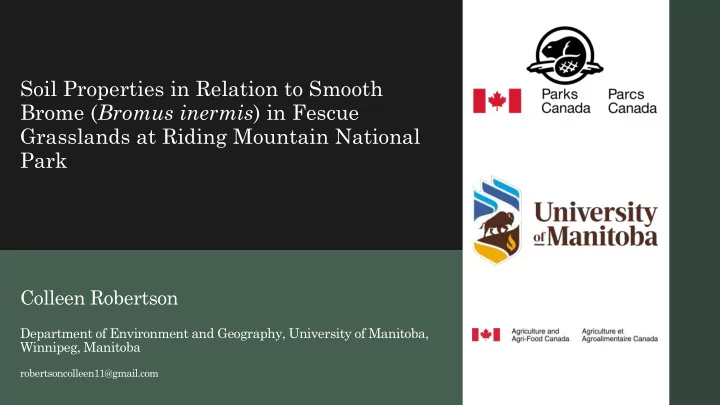

Soil Properties in Relation to Smooth Brome ( Bromus inermis ) in Fescue Grasslands at Riding Mountain National Park Colleen Robertson Department of Environment and Geography, University of Manitoba, Winnipeg, Manitoba robertsoncolleen11@gmail.com
Objectives • Understand the differential invasion of smooth brome as it spreads from the initial point of introduction • Understand the impact smooth brome stands have on soil properties • Consider geophysical imaging as a tool in smooth brome monitoring and management
Background • Smooth brome threatens ecological integrity of grassland ecosystems (Otfinowski et al., 2007) • Initially introduced via roads and trails, spreads differentially into surrounding ecosystems (Gifford and Otfinowski, 2013) • Stands decrease in density over time — depletion of nutrients (Otfinowski et al., 2007) • Roots are dense and extend deep into soil (Piper et al., 2015) • Higher moisture requirement than many grassland plants (Stotz et al., 2016) If water is limited, will grow where soil moisture is highest
Hypotheses 1. Smooth brome will be present where higher moisture content is available and where soils are acidic 2. Plant nutrients will be depleted where smooth brome is present 3. Soil will have a higher proportion of organic carbon where smooth brome is present 4. Water availability will be a more important factor in the xeric prairie than the mesic prairie
Location and Site Selection • Data collected July-August 2019 in Riding Mountain National Park, Manitoba • Study focused on Grasshopper Valley and Peden Prairie Grasshopper Valley Peden Prairie Geographically separated Differing moisture content • 5 hectare area defined for study in each grassland
Soil Sampling Many roots 0-15cm 15-30cm 30-45cm 45-60cm Very few roots Peden Prairie Grasshopper Valley
Soil Sampling and Laboratory Analyses • Litter depth and surface volumetric moisture also sampled at each site • Soil samples analyzed for: pH EC Available phosphorus Available nitrogen Total Nitrogen Total Carbon Total Organic Carbon C:N ratio
Geophysical Imaging • Geonics EM-38 survey for ground conductance Uses EMI to measure apparent electrical conductance Influenced by moisture, texture, salinity • Digital elevation model generated by differential GPS • Drone imaging for NDVI and NDRE indices Foley, 2013 https://grdc.com.au/resources-and-publications/grdc-update-papers/tab-content/grdc-update- papers/2013/03/a-how-to-for-getting-soil-water-from-your-em38-field-measurements
Results: Soil Chemistry PO4-P NH4-N NO3-N • Smooth brome presence impacts Site Depth Brome pH TOC (%) (mg/kg) (mg/kg) (mg/kg) TOC and inorganic nitrogen present 8.51 6.5 9.3 0.3 8.00 0-15cm absent 9.28 6.8 11.7 1.0 7.17 present 4.16 6.8 5.4 4.69 15-30cm Grasshopper • Grasshopper Valley: absent 3.90 7.3 5.1 3.88 Valley present 2.82 7.1 3.6 2.99 30-45cm absent 3.87 8.0 4.2 2.42 Smooth brome not effecting soil present 3.24 7.3 3.6 0.127 properties in the 45-60cm range 45-60cm absent 4.61 8.0 4.2 0.207 (no difference in TOC) present 8.59 6.5 7.1 1.8 8.70 0-15cm absent 11.09 6.1 10 1.4 8.80 Significant difference in pH and present 4.5 6.7 5.6 5.49 15-30cm available phosphorus in the 45- absent 2.41 6.4 5.2 3.70 Peden Prairie 60cm range present 2.88 7.3 4.1 3.22 30-45cm absent 1.64 7.1 3.4 2.44 present 4.12 7.7 4.7 3.21 45-60cm absent 2.91 7.4 3.9 2.73
Results: Geophysical Imaging Indicates significant difference Grasshopper Valley (mesic grassland) between brome-presence and brome-absence Normalized Ground Digital Normalized Difference Conductance Elevation Difference Vegetation Model Model Red-Edge Index
Results: Geophysical Imaging Indicates significant difference Peden Prairie (xeric grassland) between brome-presence and brome-absence Digital Elevation Model Normalized Difference Vegetation Index Ground Conductance Model Normalized Difference Red-Edge
Results: Water Availability • Grasshopper Valley (mesic): Ground conductance significantly higher in brome-presence High ground conductance indicating higher soil moisture • Peden Prairie (xeric): Elevation significantly lower in brome-presence Brome is establishing in depressions- higher soil moisture
Influence of Soil Properties on Smooth Brome Invasion • Grasshopper Valley Negligible impact from brome presence in 45-60cm depth (No difference in TOC) 45-60cm depth represents pre-invasion soil condition Invasion influenced by acidic soils, low available phosphorus, and high ground conductance • Peden Prairie Mostly dictated by proximity to the trail Depressed elevation
Geophysical Imaging in Smooth Brome Management • Small scale conductance and elevation changes can be used to create a model of invasion susceptibility Next steps: improve resolution of models, minimize disturbance to grassland • NDRE has potential to be used to map smooth brome foci over large areas • Further research needed to refine models
Conclusion • Factors determining invasion risk depend on the moisture content of the grassland Peden Prairie (Moisture limiting): low elevation (soil moisture) Grasshopper Valley (Moisture not limiting): acidic soils, low available phosphorus, high ground conductance (soil moisture) • Geophysical imaging has the potential to enhance monitoring and management practices of smooth brome and other invasive species Research to refine models is needed for the effective use of imaging techniques
References Gifford, M., & Otfinowski, R. (2013). Landscape Disturbances Impact Affect the Distribution and Abundance of Exotic Grasses in Northern Fescue Prairies, 577 – 584. Otfinowski, R., Kenkel, N. C., & Catling, P. M. (2007). The biology of Canadian weeds. 134. Bromus inermis Leyss, 2 (1982): 54 – 56. Piper, C.L., Sicilano, S.D., Winsley, T, Lamb, E.G. (2015) Smooth brome invasion increases rare soil bacteria species prevalence, bacterial species richness and evenness. Journal of Ecology. 103: 386-396. Stotz, G., Dettlaff, M., Pec, G., Inderjit, Carrigy, A., Stotz , G., … Cahill, J. (2016). Community -level determinants of smooth brome ( Bromus inermis ) growth and survival in the aspen parkland. Plant Ecology , 217 (11), 1395 – 1413.
Questions? Thank you: Mario Tenuta and Peter Tarleton for your guidance Mervin Bilous, Matt Gervais, and Krista Hanis-Gervais from the U of M ASEL John Fitzmaurice, Matthew Friesen and Mike Chubey from Agriculture and Agri- food Canada Roxanne Grzela, Roberta Tesar, Skye Rees, Kathryn Yarchuk, Sean Frey, Melanie Robinson and others from the Riding Mountain National Park resource conservation team Norman Kenkel and Cole Stocki for assistance with analyses
Recommend
More recommend